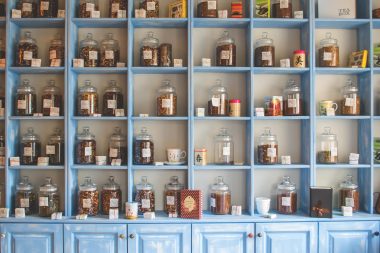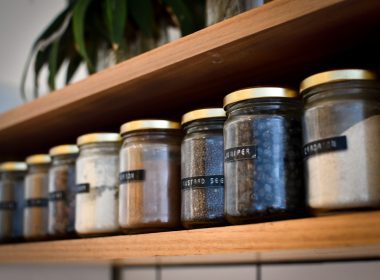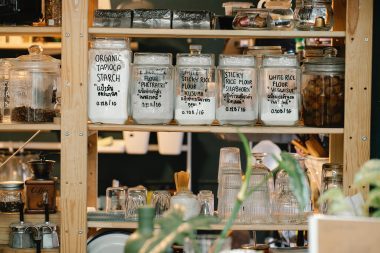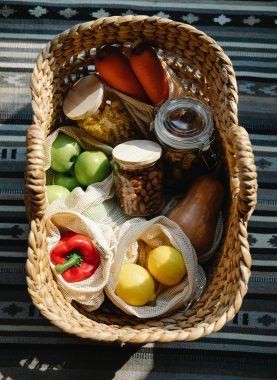You try, and try, and try, but no matter how organized you think you are, two weeks after the great cleanout, your pantry is a hot mess. How did it get this way? What can you do? Is it all just pointless? The good news:: you can have an organized pantry! And, believe it or not, it can actually stay organized. It just takes a little help and creativity. Read on for some tools of the trade: the ultimate guide to pantry organization!

Don’t Buy What You Don’t Use
The first step, and the key to pantry organization (and an organized life), is to stop buying things you don’t use. It definitely feels like you’ll start eating healthier if you just pick up that box of steel-cut oats or the latest protein shake. And you really want to start making all of your bread and pasta from scratch, so you just have to try those four different kinds of flour, right?
Maybe, but probably not. It’s ok to make the effort to try new things. But when you go to organize, you’ll find many of those motivating goods are still sitting unopened and forgotten in the back corners of the cabinet. To avoid overbuying, limit yourself to one new product a month. And place it up front where you’ll see it every time you open the pantry. If you haven’t used it after a month, chances are good that you aren’t going to. Toss (or, if possible, donate) it, and move on. You have enough going on to worry about things you didn’t try. If you stick to this practice, you’ll find you have more space, more money, and less guilt. It’s a true win-win for your pantry and your budget!
Use Labeled Containers For (some) Products
Every pantry photo in every magazine ever has one thing in common: cute labeled jars and bins. They are just so pretty, all perfectly lined up on your shelves. But sometimes putting items in jars or bins just doesn’t make sense when it comes to pantry organization.
Some items lend themselves to labeled containers to make locating them easier and to preserve freshness. Other things…not so much. The wicker basket you found on sale last week is beautiful, but it’s just going to make finding the tomato soup harder when there are 30 cans in a basket on a shelf. So go ahead and use those cute jars and bins—just use them sparingly.

Here’s a list of items that work well in containers:
- Pasta – pasta comes in bags or boxes, neither of which are easily resealable. Use labeled, airtight containers to keep them fresh and easily accessible.
- Dry Goods – like pasta, coffees, flour, sugar, rice, and other dry goods work well in airtight containers.
- Beans – Beans look really good in jars, and will last longer if properly sealed.
- Spices – Ok, yes. They already come in containers. But if you’re going to splurge on making things look pretty, having matching spice containers all lined up on a shelf will do the trick. If you’re going to splurge, this is a good place to do it. Just remember not to buy tons of spices you won’t use. And keep the spices you regularly use on the front row in cute jars while the less used spices are tucked further back.
- Cereals – Let’s be real. We all know those box flaps do nothing to keep your cereal fresh.
A few last container tips: consider using a chalkboard or other reusable labels for items that can go stale (like cereal and pasta). Then, label them with expiration dates instead of a description of the contents. Or, better yet, have your kids label them as a fun chore when you get home from grocery shopping. That way, you’re never left guessing if you bought that cereal two years or two weeks ago. And make sure your containers have large openings—there’s nothing more frustrating than not being able to fit a measuring cup or spoon in a container when baking!

Think Outside The Pantry
The organization should equal ease. So, anything you can do to cut down on your effort will result in long-term success. To help with keeping your pantry organized, start before anything even goes through the pantry door. When you shop, organize your groceries based on their use and then store them the same way. Use sustainable organizers for items like your kids’ snacks. Drop them in the tote when you buy them; then just throw the whole tote in the pantry on a low shelf for easy access when your kids pack their lunch (yes…your kids can pack their own lunches and do other household chores!!!). By making these small changes, you can go from store to store in a flash!

Also, consider how goods leave the pantry. Put items you frequently use together in the same area. For example, put all of your cake baking and decorating items in one place. Or, have one shelf dedicated to grown-up snacks and another reserved for kids’ snacks. If you want to use those beautiful baskets you’ve been eyeing, try organizing food by meal. Plan ahead when shopping, then put all of the ingredients for each evening’s meal in a separate basket. When you get home after an exhausting day of work, you can just pull out the basket and be ready to go (here are some ideas for perfect meals to get you started).
A Few Last Words
The last thing to remember is that like anything, having and keeping a functionally organized pantry is not a one-and-done thing. It’s going to require a little discipline on your part, and it’s going to be an ongoing task. It may take some trial and error to find just the right arrangement but, with some dedication, creativity, and planning, you’ll get there and love it. As your family’s tastes change, you will likely have to re-organize—and that’s ok. Reorganizing will get easier and easier as you learn how you and your family best use a functioning pantry. And every time you open that door, you’ll know the upfront effort was well worth it!





















